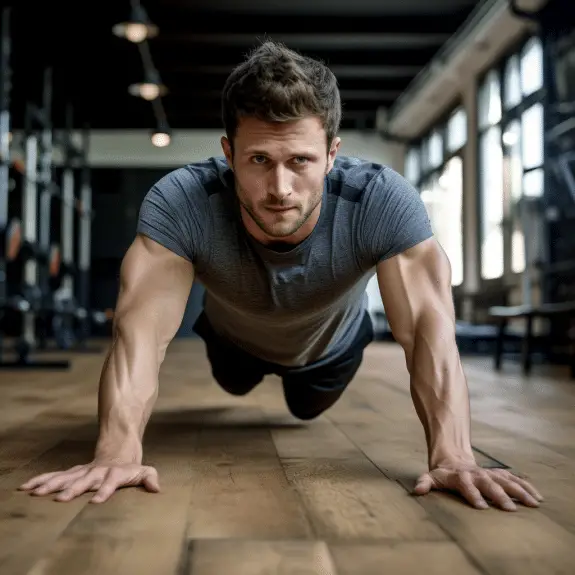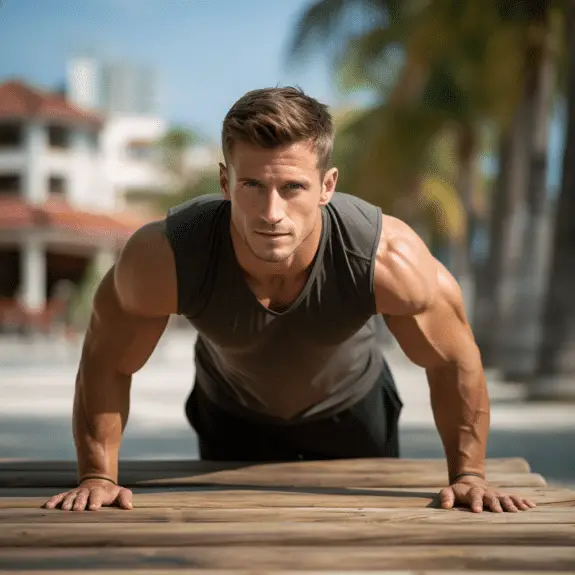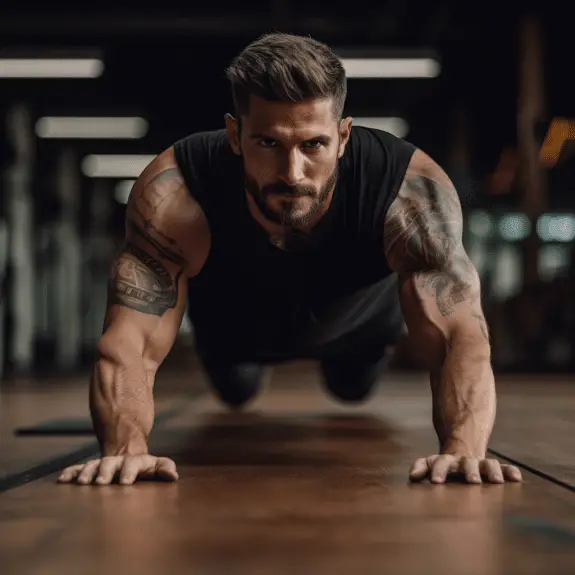Introduction
Physical and Mental Growth Improving your plank performance is a journey of both physical and strength. Planks, a deceptively simple yet incredibly effective exercise, have become a benchmark of core strength and endurance. Whether you’re a fitness enthusiast seeking to increase your plank duration or a beginner looking to master the basics, this quest for improvement has valuable lessons for everyone. We will uncover the secrets to mastering planks, from proper form and technique to progressive challenges. We will delve into the benefits of planks, both for core stability and full-body engagement. Moreover, we’ll unlock the mental strategies that enable you to push your limits and overcome the discomfort that can accompany longer planks.
Planks are more than just a static exercise; they are a testament to the power of resilience and determination. Whether you aim to break personal records, develop a rock-solid core, or simply enjoy the satisfaction of completing a challenging workout, your journey to improving planks promises growth, both physically and mentally. In the world of fitness, planks have risen to prominence as one of the most effective and versatile exercises. They target not only the abdominal muscles but also the entire core, as well as the shoulders, arms, and legs. The appeal of good planks lies in their simplicity, yet they are a formidable test of endurance.
The art of improving planks will take you through the fundamental techniques, the science behind their effectiveness, and strategies to help you progress. We’ll uncover the secrets to maintaining proper form and alignment, which are essential to avoid injury and maximize benefits. The benefits of planks extend far beyond the visible physical gains. They teach discipline, patience, and mental fortitude, making your to improved planks a profound exercise in both body and mind. Whether you’re aiming to break personal records, achieve a more defined core, or simply enjoy a more robust and healthier body, your path to mastering planks is of self-discovery and empowerment.

How fast can I improve my plank?
If you’re new to planks or don’t do them very often, you can start with smaller timed sets and work your way up over time. For example, you could start with 3 sets of 30-second planks three times a week for one or two weeks, then aim for 35 seconds, and so on.
Starting Point: If you’re relatively new to planks or have not incorporated them into your routine, you may experience initial improvements relatively quickly. Progress is often faster for beginners because their bodies are adapting to a new stimulus.
Consistency: Consistency is key in improving your plank time. Regular practice, several times a week, is more likely to yield faster progress. Consistency allows your muscles to adapt and become more efficient in maintaining the plank position.
Incremental Increases: Incremental progression is a proven method for improving plank time. Start with shorter timed sets, and gradually increase the duration as your strength and endurance improve. This gradual approach reduces the risk of overtraining and helps prevent injury.
Individual Variability: Everyone’s body responds differently to exercise. Some individuals may see significant improvements in a matter of weeks, while others may require more time. Genetics, diet, and overall lifestyle factors can influence the rate of improvement.
Proper Form: Maintaining proper form during planks is crucial for safety and effectiveness. As your plank time increases, be diligent about sustaining good form to prevent injury and maintain progress.
What is the most effective way to do planks?
Press your hands and knees to the floor with your back in a neutral position and wrists aligned directly under your shoulders. Gaze about one foot in front of you. Your nose should point toward the floor and the back of your neck should be parallel to the ceiling.
Starting Position: Begin by positioning yourself on the floor with your hands and knees. Your hands should be directly under your shoulders, and your knees under your hips. This creates a stable foundation.
Wrist Alignment: Ensure that your wrists are aligned directly under your shoulders. This alignment helps distribute your body weight evenly and minimizes strain on your wrists.
Neutral Spine: Keep your back in a neutral position, which means it should be flat and in line with your neck and hips. Avoid arching or rounding your back.
Gaze Direction: Look about one foot in front of you. Your gaze should be directed downward, with your nose pointing toward the floor. This position helps maintain proper neck alignment.
Engage Core: Tighten your core muscles, including your abdominals and obliques. Imagine pulling your belly button toward your spine to create a strong, stable core.
How long is a good plank a day?
As a general guideline, Doug Sklar, a certified personal trainer and founder of PhilanthroPIST in New York City, recommends striving to do three sets of up to 60 seconds. “It’s OK to start with shorter sets and work up to 60 seconds,” he says. Plus, shorter planks can still give you a solid workout, Sklar says.
Starting Point: If you’re new to planking or have a weaker core, it’s perfectly fine to start with shorter sets, even as short as 10-20 seconds. This allows your body to build up strength gradually.
Progression: As you get more comfortable and stronger, you can gradually increase the duration of your plank. Aim to work up to three sets of 60 seconds, as Doug Sklar suggests. This is a challenging goal that can provide excellent core strength benefits.
Quality Over Quantity: It’s important to focus on maintaining proper form throughout the plank. A shorter, well-executed plank is more effective than a longer one with poor form.
Variation: To keep your routine interesting and work different muscle groups, you can incorporate side planks, forearm planks, or other plank variations.
Consistency: Consistency is key in any fitness routine. Doing planks daily or several times a week can lead to better results over time.
What is the easiest plank position?
Forearm plank
This variation, one of the most common ways to perform a plank, is slightly easier than holding your body up with just your hands. Place forearms on the floor with elbows aligned below shoulders and arms parallel to your body at about shoulder width.
Starting Position: Begin by kneeling on the floor.
Forearms: Place your forearms on the ground, parallel to each other, with your elbows positioned directly under your shoulders. Your hands should be in fists or flat on the ground.
Alignment: Make sure your body forms a straight line from your head to your heels. Engage your core muscles to keep your back straight.
Legs: Extend your legs straight behind you, with your toes on the ground.
Hips: Keep your hips level and in line with your body. Don’t let your hips sag or pike upwards.
Hold: Maintain this position for the desired duration. Beginners can start with shorter durations and gradually work their way up.
What are the benefits of high planks?
Holding yourself in a high plank position activates and stretches your core, shoulders, legs, and lower-back muscles, increasing your stability and improving your everyday posture.
Core Strength: High planks primarily target the core muscles, including the rectus abdominis, transverse abdominis, and obliques. This helps in building a stronger and more stable core, which is essential for overall strength and stability.
Upper Body Strength: High planks engage the shoulder, chest, and upper back muscles, helping to improve upper body strength and endurance.
Posture Improvement: Regularly practicing high planks can help improve your posture. Strengthening the core and upper body muscles can reduce the likelihood of slouching and promote better alignment of the spine.
Stability: High planks are excellent for enhancing overall stability. They require you to balance on your hands and toes, which can improve your balance and stability, making everyday movements easier.
Full-Body Workout: While the core and upper body receive the most emphasis, high planks also engage the leg and lower-back muscles, providing a comprehensive full-body workout.
Do planks target lower abs?
The plank is a great exercise to build not only abdominal strength, but full body strength. To get the full benefits of this exercise for your lower abs, you need to make slight adjustments. Many people let their hips sag while performing this move.
Hanging Leg Raises: Hanging leg raises are an excellent exercise for targeting the lower abs. Hang from a pull-up bar or similar apparatus, and then lift your legs, keeping them straight, until they are parallel to the ground. Lower them back down with control.
Reverse Crunches: Lie on your back with your hands at your sides or under your hips for support. Lift your legs off the ground and bend your knees at a 90-degree angle. Contract your lower abs to lift your hips off the ground, and then lower them back down.
Bicycle Crunches: While not solely targeting the lower abs, bicycle crunches engage the entire core and can help work the lower abs. Lie on your back, lift your legs, and perform a cycling motion while bringing your opposite elbow to your knee.
Leg Raises: Lie on your back with your hands under your hips for support. Lift your legs straight up, keeping them together. Slowly lower your legs toward the ground without letting them touch it, and then raise them back up.
Plank Variations: You can modify the plank exercise to emphasize the lower abs by lifting one leg at a time or performing knee-to-chest planks. These variations require extra effort from the lower abdominal muscles.
Do planks give results?
“Plank exercises generally strengthen your ability to brace your abdominals,” notes Lawton. “Planks can also activate other related muscles, such as your glutes (muscles in your buttocks), hamstrings (muscles in the backs of your thighs) and lower back.”
Maintain Proper Form: To engage the lower abs, it’s crucial to keep your hips in a neutral position and prevent them from sagging. Your body should form a straight line from your head to your heels. Avoid letting your hips drop or picking them up.
Tuck Your Pelvis: Slightly tucking your pelvis and engaging the lower part of your abdominal muscles can help emphasize the lower abs.
Squeeze Your Glutes: Contract your glutes (buttocks) while holding the plank. This can help stabilize your pelvis and maintain a neutral position.
Focus on Breathing: Concentrate on your breath and engage your lower abs by drawing your navel toward your spine while breathing out.
Progressive Work: As you become more experienced with planks, you can increase the challenge to your lower abs by incorporating variations such as knee-to-chest planks or plank leg lifts. These movements put extra emphasis on the lower abdominal region.
How much plank is normal?
The general recommendation by fitness professionals is that there is no need ever to do a plank longer than two minutes, and if you are doing so, you are either doing it wrong or you should break up the plank into different sets. Planking for 30 seconds or 60 seconds at most is ideal.
Quality Over Quantity: It’s essential to maintain proper form during the plank. Holding a perfect plank for 30 seconds or 60 seconds can be more effective than holding a longer one with poor form.
Progression: As you get more comfortable and stronger, you can gradually increase the duration of your plank. Progressing to two minutes or longer can be a goal for some individuals with advanced fitness levels, but this isn’t necessary for everyone.
Set Breaks: Breaking up longer plank sessions into sets with brief rests in between can be an effective way to challenge yourself without compromising form.
Variation: You can make planking more interesting and work different muscle groups by incorporating plank variations, such as side planks, forearm planks, or plank leg lifts.
Individual Variation: What’s “normal” can vary widely from person to person. Some individuals may find 30 seconds challenging, while others may comfortably hold a plank for two minutes or more.

Conclusion
Planks are a foundational exercise for building a strong core and overall body stability. To enhance your plank performance, it’s vital to emphasize a few key principles. First and foremost, maintaining proper form, such as a straight line from head to heels and a strong engagement of your core muscles, is essential. Consistency is the cornerstone of improvement; integrating planks into your regular workout routine and gradually increasing the duration will yield significant progress over time. Diversifying your plank routine with variations like side planks, forearm planks, and leg lifts can add excitement and challenge to your workouts, preventing plateaus.
Paying attention to your breath and using it to engage your core will help maximize the effectiveness of your planks. Lastly, implementing progressive overload techniques, such as longer holds, multiple sets, or more demanding variations, will contribute to steady improvement. By adhering to these guidelines and staying committed to your plank routine, you can develop a stronger core and experience the numerous benefits that come with mastering this foundational exercise. Continuing on the theme of plank improvement, it’s worth noting that planks not only build physical strength but also mental resilience. As you progress in your plank practice, you’ll develop mental fortitude and discipline. The ability to hold a challenging position for an extended period requires focus and mental strength, which can carry over into other areas of your life.
Proper nutrition and overall fitness are critical compliments to your plank routine. A balanced diet and cardiovascular exercises can help reduce body fat, allowing your well-toned core muscles to shine through. Pair your planks with a well-rounded fitness regimen to see the best results. Improving your planks is about more than just the physical aspect; it’s a holistic approach that combines proper form, consistency, variation, breath control, and progressive overload. With dedication and patience, you can enhance your core strength, boost your mental resilience, and achieve a healthier and fitter lifestyle. So, continue to challenge yourself and enjoy the of plank improvement.

